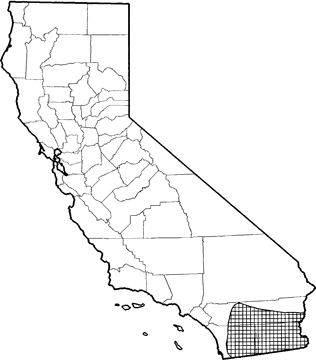
Pocketed Free-tailed Bat
Distribution, Abundance, and Seasonality
The pocketed free-tailed bat is found in Riverside, San Diego, and Imperial cos. This species is rare in California, but is more common in Mexico. Habitats used include pinyon-juniper woodlands, desert scrub, desert succulent shrub, desert riparian, desert wash, alkali desert scrub, Joshua tree, and palm oasis.

Range Map
Specific Habitat Requirements
Feeding: Feeds on flying insects detected by echolocation high over ponds, streams, or arid desert habitat. Large moths are the principal food, but a wide variety of insects is taken (Easterla and Whitaker 1972). Flight is swift and direct.
Cover: Prefers rock crevices in cliffs as roosting sites. Must drop from the roost to gain flight speed.
Reproduction: Reproduces in rock crevices, caverns, or buildings.
Water: No data found.
Pattern: Prefers rocky desert areas with high cliffs or rock outcrops.
Species Life History
Activity Patterns: Nocturnal. Probably active yearlong. Emerges from the roost well after sunset, after solar radiation has ceased (Gould 1961). Activity is curtailed by rain.
Seasonal Movements / Migration: Probably a yearlong resident.
Home Range: No data found.
Territory: Usually roosts in small groups. A group of 50-60 was found in San Diego Co. (Krutzsch 1944b).
Reproduction: Young are born in June and July, peaking in late June. The single litter has 1 young. Lactation occurs in July and August.
Niche: A swift, high-flying species; probably a moth specialist. An instance of predation by the Iyre snake is described by Krutzsch (1944a).
Comments: The status of this species in California is poorly known, but it appears to be rare. The roost described by Krutzsch (1944b) is abandoned, although an active roost is located in Anza Borrego State Park. A California Species of Special Concern (Williams 1986).
Sources & References
California Department of Fish and Game, 1999.
California's Wildlife, Sacramento, CA.
Written by: J. Harris, reviewed by: P. Brown, edited by: D. Alley, R. Duke
Barbour, R. W., and W. H. Davis. 1969. Bats of America. Univ. of Kentucky Press, Lexington. 286pp. Benson, S. B. 1940. Notes on the pocketed free-tailed bat. J. Mammal. 21:26-29. Cockrum, E. L. 1956. Homing, movements and longevity of bats. J. Mammal. 37:48-57. Constantine, D. G. 1958. Tadarida femorasacca and Tadarida molassa at Carlsbad Caverns, New Mexico. J. Mammal. 39:293. Easterla, D. A. 1973. Ecology of the 18 species of Chiroptera at Big Bend National Park, Texas. Northwest Mo. State Univ. Studies 34:1-165. Easterla, D. A., and J. O. Whitaker, Jr. 1972. Food habits of some bats from Big Bend National Park, Texas. J. Mammal. 53:997-890. Gould, P. J. 1961. Emergence time of Tadarida in relation to light intensity. J. Mammal. 42:405-407. Krutzsch, P. H. 1944a. California lyre snake feeding on the pocketed bat. J. Mammal. 25:410. Krutzsch, P. H. 1944b. Notes on the little-known pocketed bat. J. Mammal. 25:201. Neil, R. W. 1940. The pocketed bat in California. J. Mammal. 21:356. Williams, D. F. 1986. Mammalian species of special concern in California. Calif. Dept. Fish and Game, Sacramento. Admin. Rep. 86-1. 112pp.
California Animal Facts | California's Wildlife